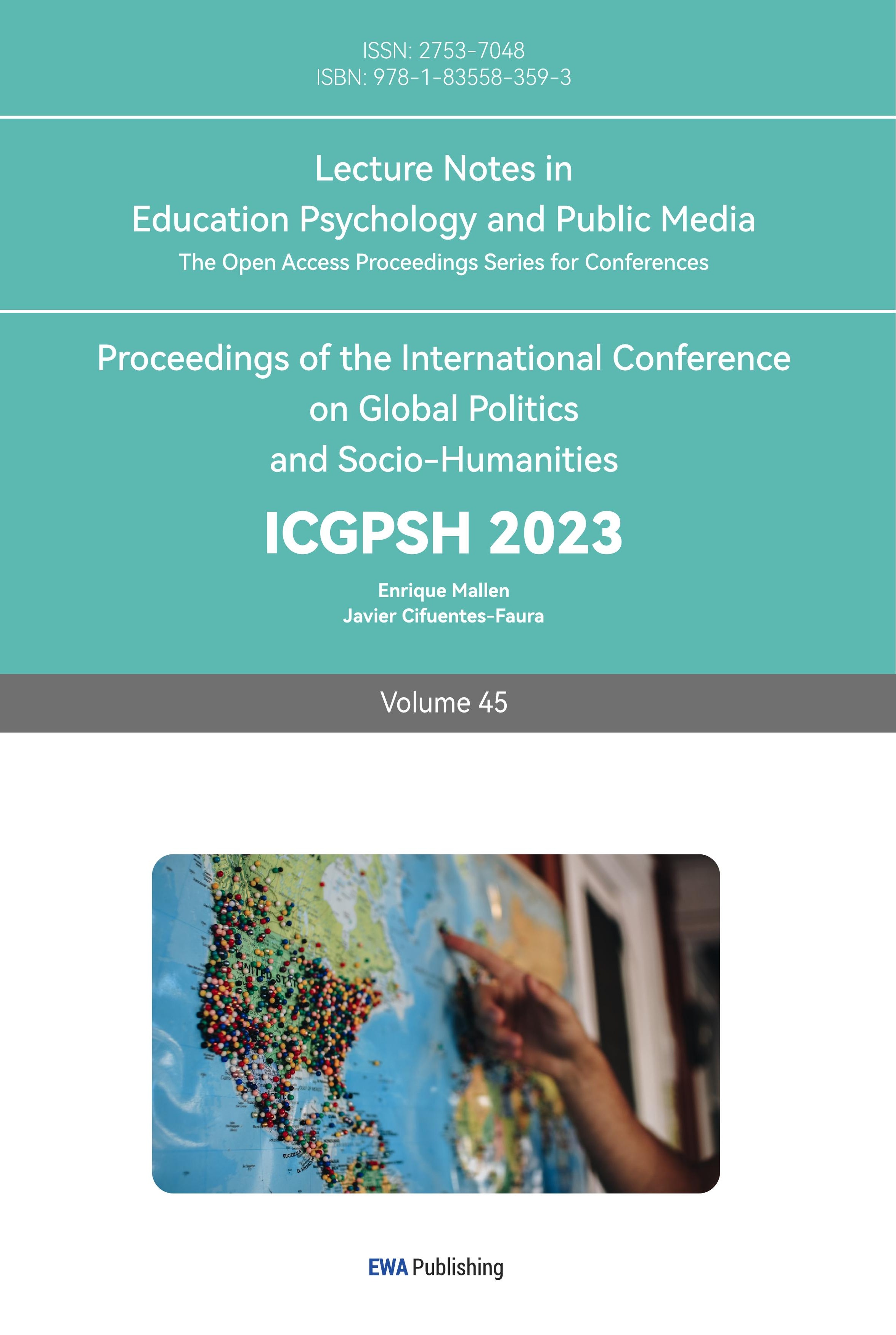References
[1]. Hettema, J. M. (2008). The nosologic relationship between generalized anxiety disorder and major depression. Depression and Anxiety, 25(4), 300–316. https://doi.org/10.1002/da.20491
[2]. Simkin, D. R. (2019). Microbiome and Mental Health, Specifically as It Relates to Adolescents. Current Psychiatry Reports, 21(9). https://doi.org/10.1007/s11920-019-1075-3
[3]. López, D. E., & Ballaz, S. J. (2020). The Role of Brain Cyclooxygenase-2 (Cox-2) Beyond Neuroinflammation: Neuronal Homeostasis in Memory and Anxiety. Molecular Neurobiology, 57(12), 5167–5176. https://doi.org/10.1007/s12035-020-02087-x
[4]. Dean, J., & Keshavan, M. (2017). The neurobiology of depression: An integrated view. Asian Journal of Psychiatry, 27(27), 101–111. https://doi.org/10.1016/j.ajp.2017.01.025
[5]. Vogt, M. E., Riesgo, V. R., Flanigan, K. A. S., & Willing, J. G. (2022). Housing Environment Affects Pubertal Onset, Anxiety-like Behavior, and Object Interaction in Male and Female Long Evans Rats. Journal of the American Association for Laboratory Animal Science, 61(3), 241–247. https://doi.org/10.30802/aalas-jaalas-21-000119
[6]. Alboni, S., van Dijk, R. M., Poggini, S., Milior, G., Perrotta, M., Drenth, T., Brunello, N., Wolfer, D. P., Limatola, C., Amrein, I., Cirulli, F., Maggi, L., & Branchi, I. (2017). Fluoxetine effects on molecular, cellular and behavioral endophenotypes of depression are driven by the living environment. Molecular Psychiatry, 22(4), 552–561. https://doi.org/10.1038/mp.2015.142
[7]. Yap, M. B. H., Pilkington, P. D., Ryan, S. M., & Jorm, A. F. (2014). Parental factors associated with depression and anxiety in young people: A systematic review and meta-analysis. Journal of Affective Disorders, 156, 8–23. https://doi.org/10.1016/j.jad.2013.11.007
[8]. Haddad, C., Chidiac, J., Sacre, H., Salameh, P., Hallit, R., Obeid, S., Soufia, M., & Hallit, S. (2022). Prevalence and Associated Factors of Social Anxiety Among Lebanese Adolescents. The Primary Care Companion for CNS Disorders, 24(3). https://doi.org/10.4088/pcc.21m03061
[9]. Annette M. La Greca (Ed.). (1999). Social anxiety scales for children and adolescents : manual and instructions for the SASC, SASC-R, SAS-A (adolescents), and parent versions of the scales | WorldCat.org. Www.worldcat.org. https://www.worldcat.org/zh-cn/title/social-anxiety-scales-for-children-and-adolescents-manual-and-instructions-for-the-sasc-sasc-r-sas-a-adolescents-and-parent-versions-of-the-scales/oclc/45382637
[10]. Quick Inventory of Depressive Symptomatology (QIDS). (n.d.). MDCalc. https://www.mdcalc.com/calc/1845/quick-inventory-depressive-symptomatology-qids
Cite this article
Hao,A.Z. (2024). The Effect of the Learning Environment on Students’ Anxiety and Depression Levels. Lecture Notes in Education Psychology and Public Media,45,94-101.
Data availability
The datasets used and/or analyzed during the current study will be available from the authors upon reasonable request.
Disclaimer/Publisher's Note
The statements, opinions and data contained in all publications are solely those of the individual author(s) and contributor(s) and not of EWA Publishing and/or the editor(s). EWA Publishing and/or the editor(s) disclaim responsibility for any injury to people or property resulting from any ideas, methods, instructions or products referred to in the content.
About volume
Volume title: Proceedings of the International Conference on Global Politics and Socio-Humanities
© 2024 by the author(s). Licensee EWA Publishing, Oxford, UK. This article is an open access article distributed under the terms and
conditions of the Creative Commons Attribution (CC BY) license. Authors who
publish this series agree to the following terms:
1. Authors retain copyright and grant the series right of first publication with the work simultaneously licensed under a Creative Commons
Attribution License that allows others to share the work with an acknowledgment of the work's authorship and initial publication in this
series.
2. Authors are able to enter into separate, additional contractual arrangements for the non-exclusive distribution of the series's published
version of the work (e.g., post it to an institutional repository or publish it in a book), with an acknowledgment of its initial
publication in this series.
3. Authors are permitted and encouraged to post their work online (e.g., in institutional repositories or on their website) prior to and
during the submission process, as it can lead to productive exchanges, as well as earlier and greater citation of published work (See
Open access policy for details).
References
[1]. Hettema, J. M. (2008). The nosologic relationship between generalized anxiety disorder and major depression. Depression and Anxiety, 25(4), 300–316. https://doi.org/10.1002/da.20491
[2]. Simkin, D. R. (2019). Microbiome and Mental Health, Specifically as It Relates to Adolescents. Current Psychiatry Reports, 21(9). https://doi.org/10.1007/s11920-019-1075-3
[3]. López, D. E., & Ballaz, S. J. (2020). The Role of Brain Cyclooxygenase-2 (Cox-2) Beyond Neuroinflammation: Neuronal Homeostasis in Memory and Anxiety. Molecular Neurobiology, 57(12), 5167–5176. https://doi.org/10.1007/s12035-020-02087-x
[4]. Dean, J., & Keshavan, M. (2017). The neurobiology of depression: An integrated view. Asian Journal of Psychiatry, 27(27), 101–111. https://doi.org/10.1016/j.ajp.2017.01.025
[5]. Vogt, M. E., Riesgo, V. R., Flanigan, K. A. S., & Willing, J. G. (2022). Housing Environment Affects Pubertal Onset, Anxiety-like Behavior, and Object Interaction in Male and Female Long Evans Rats. Journal of the American Association for Laboratory Animal Science, 61(3), 241–247. https://doi.org/10.30802/aalas-jaalas-21-000119
[6]. Alboni, S., van Dijk, R. M., Poggini, S., Milior, G., Perrotta, M., Drenth, T., Brunello, N., Wolfer, D. P., Limatola, C., Amrein, I., Cirulli, F., Maggi, L., & Branchi, I. (2017). Fluoxetine effects on molecular, cellular and behavioral endophenotypes of depression are driven by the living environment. Molecular Psychiatry, 22(4), 552–561. https://doi.org/10.1038/mp.2015.142
[7]. Yap, M. B. H., Pilkington, P. D., Ryan, S. M., & Jorm, A. F. (2014). Parental factors associated with depression and anxiety in young people: A systematic review and meta-analysis. Journal of Affective Disorders, 156, 8–23. https://doi.org/10.1016/j.jad.2013.11.007
[8]. Haddad, C., Chidiac, J., Sacre, H., Salameh, P., Hallit, R., Obeid, S., Soufia, M., & Hallit, S. (2022). Prevalence and Associated Factors of Social Anxiety Among Lebanese Adolescents. The Primary Care Companion for CNS Disorders, 24(3). https://doi.org/10.4088/pcc.21m03061
[9]. Annette M. La Greca (Ed.). (1999). Social anxiety scales for children and adolescents : manual and instructions for the SASC, SASC-R, SAS-A (adolescents), and parent versions of the scales | WorldCat.org. Www.worldcat.org. https://www.worldcat.org/zh-cn/title/social-anxiety-scales-for-children-and-adolescents-manual-and-instructions-for-the-sasc-sasc-r-sas-a-adolescents-and-parent-versions-of-the-scales/oclc/45382637
[10]. Quick Inventory of Depressive Symptomatology (QIDS). (n.d.). MDCalc. https://www.mdcalc.com/calc/1845/quick-inventory-depressive-symptomatology-qids









